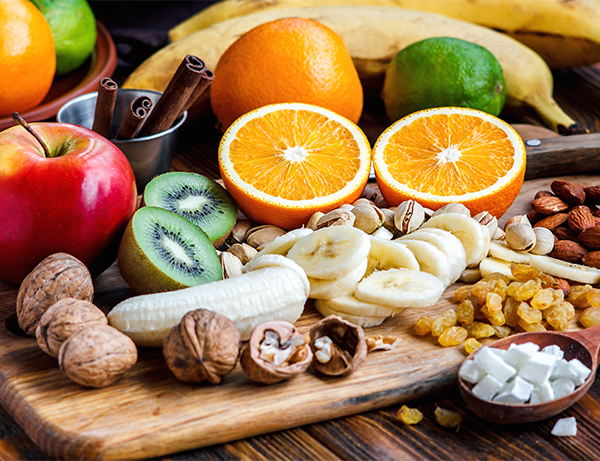
Imagine walking through a bustling farmer’s market on a crisp autumn morning, the air filled with the sweet scent of ripe apples and juicy pears. You pick up a vibrant, sun-kissed peach, and as you bite into it, the burst of flavor feels like a gift from the earth itself. There’s something magical about eating fruits that are in season—they taste better, feel fresher, and somehow make you feel more connected to the world around you. But beyond the sensory delight, there’s a deeper question: Why are seasonal fruits better for your health? In this comprehensive guide, we’ll explore the science, stories, and practical benefits of choosing seasonal fruits, weaving together expert insights, personal anecdotes, and actionable advice to show why they’re a cornerstone of a healthy lifestyle.
The Nutritional Powerhouse of Seasonal Fruits
Seasonal fruits are nature’s way of delivering exactly what your body needs, when it needs it. Fruits harvested at their peak ripeness are packed with vitamins, minerals, and antioxidants that are often diminished in off-season produce shipped from afar. For example, a study published by the National Institutes of Health found that fruits picked at peak ripeness retain higher levels of nutrients like vitamin C and polyphenols compared to those harvested early for long-distance transport. When you bite into a summer strawberry or a winter citrus, you’re getting a nutritional jackpot that’s perfectly aligned with what your body craves.
Take my own experience: last summer, I decided to swap my usual store-bought apples (which, let’s be honest, can taste like cardboard in June) for locally grown cherries from a nearby orchard. The difference was night and day—not only were the cherries bursting with flavor, but I also felt more energized after eating them. It got me wondering: was it just the taste, or was there something more? Turns out, seasonal fruits like cherries are rich in antioxidants like anthocyanins, which help reduce inflammation and boost immunity—perfect for the active summer months.
Why It Matters:
- Higher Nutrient Density: Seasonal fruits are harvested at their peak, preserving vitamins and minerals.
- Natural Alignment: Your body benefits from nutrients tailored to the season, like vitamin C-rich citrus in winter to fight colds.
- Fewer Preservatives: Locally sourced seasonal fruits are less likely to be treated with chemicals to extend shelf life.
The Environmental and Economic Benefits of Eating Seasonally
Choosing seasonal fruits isn’t just good for your health—it’s a win for the planet and your wallet too. When you buy fruits in season, you’re often supporting local farmers who use sustainable practices, reducing the carbon footprint associated with long-distance shipping. According to the Environmental Working Group, locally grown produce requires less energy for transportation and storage, cutting down on greenhouse gas emissions. Plus, seasonal fruits are often more affordable because they’re abundant and don’t incur high import costs.
I remember visiting a local farm stand last spring, where I found baskets of plump, juicy strawberries at half the price of the supermarket’s imported ones. Not only did I save money, but I also learned from the farmer how growing strawberries in their natural season required fewer pesticides and less water. It felt like a small but meaningful way to support both my health and the environment.
Key Benefits:
- Lower Carbon Footprint: Less transportation means fewer emissions.
- Support Local Economies: Buying from local farmers keeps money in your community.
- Cost-Effective: Seasonal fruits are often cheaper due to high supply and lower logistics costs.
Seasonal Fruits and Your Body’s Natural Rhythm
Have you ever noticed how certain fruits just seem to “fit” the season? There’s a reason for that. Nature provides fruits that align with our body’s seasonal needs. In winter, citrus fruits like oranges and grapefruits, loaded with vitamin C, help bolster your immune system against colds and flu, as noted by the Harvard T.H. Chan School of Public Health. In summer, hydrating fruits like watermelon and peaches keep you refreshed and replenish electrolytes lost through sweat.
This connection isn’t just anecdotal—it’s rooted in biology. Our bodies evolved to thrive on the foods available in specific seasons. For instance, summer fruits like berries are high in antioxidants that protect against UV damage from increased sun exposure, while fall fruits like apples provide fiber to support digestion as we shift to heartier, warmer meals. Eating seasonally helps you tap into this natural rhythm, making you feel more balanced and energized.
Seasonal Examples:
- Spring: Strawberries and apricots, rich in vitamins to boost energy after winter.
- Summer: Watermelon and cherries, hydrating and antioxidant-packed for hot days.
- Fall: Apples and pears, high in fiber for digestive health.
- Winter: Oranges and pomegranates, immune-boosting for cold season.
The Taste Factor: Why Seasonal Fruits Win Every Time
Let’s be real—nothing beats the taste of a perfectly ripe, in-season fruit. A study from the Journal of Food Science confirms that fruits harvested at their peak have higher sugar content and better flavor profiles than those picked prematurely. Think about it: a supermarket tomato in January is often pale and tasteless, while a summer tomato from your local market is juicy, sweet, and unforgettable.
I’ll never forget the first time I tried a fresh fig from a farmer’s market in late summer. It was so sweet and tender that it felt like a dessert, unlike the bland, out-of-season figs I’d tried before. That experience sold me on the idea that seasonal eating isn’t just about health—it’s about savoring life’s simple pleasures.
Why Taste Matters:
- Better Flavor: Peak ripeness enhances natural sugars and aromas.
- Culinary Versatility: Seasonal fruits inspire creative, delicious recipes.
- Satisfaction: Tastier food means you’re more likely to eat healthily.
Comparison Table: Seasonal vs. Non-Seasonal Fruits
Seasonal vs. Non-Seasonal Fruits: A Head-to-Head Comparison
| Aspect | Seasonal Fruits | Non-Seasonal Fruits |
|---|---|---|
| Nutrient Content | High; harvested at peak ripeness, retaining maximum vitamins and antioxidants. | Lower; often picked early, losing nutrients during transport and storage. |
| Taste | Vibrant, sweet, and full-flavored due to natural ripening. | Bland or inconsistent, as fruits are ripened artificially. |
| Cost | More affordable due to local abundance and lower shipping costs. | Expensive due to import and storage costs. |
| Environmental Impact | Lower carbon footprint; supports sustainable farming. | Higher emissions from long-distance transport and storage. |
| Availability | Limited to specific seasons, but widely available at local markets. | Available year-round, but often sourced from distant regions. |
| Chemical Exposure | Fewer pesticides and preservatives due to natural growing cycles. | More likely to have chemicals for shelf-life extension. |
This table highlights why seasonal fruits are the smarter choice for health, taste, and sustainability. By prioritizing what’s in season, you’re investing in your well-being and the planet’s future.
How to Incorporate Seasonal Fruits into Your Diet
Ready to embrace seasonal eating? It’s easier than you think. Start by visiting your local farmer’s market or joining a Community Supported Agriculture (CSA) program, which delivers seasonal produce straight to your door. You can also check out seasonal produce guides, like those from the USDA, to know what’s in season in your area.
Here are some practical tips to get started:
- Plan Your Meals: Build recipes around what’s in season. For example, make a summer berry smoothie or a fall apple crisp.
- Experiment with Preservation: Freeze or can seasonal fruits to enjoy them year-round without losing nutrients.
- Mix It Up: Try new fruits each season to keep things exciting. Ever had a persimmon in fall? It’s a game-changer.
- Shop Local: Visit farmer’s markets or local grocers to find the freshest picks.
Last winter, I started blending seasonal clementines into my morning smoothies, and it was a revelation. Not only did they add a zesty kick, but I also noticed fewer colds that season. It’s amazing how small changes can make a big difference.
The Cultural and Emotional Connection to Seasonal Fruits
Eating seasonal fruits isn’t just about nutrition—it’s a cultural and emotional experience. Across the world, seasonal fruits are tied to traditions and celebrations. In Japan, for instance, the arrival of mikan (tangerines) in winter is a cozy ritual, with families sharing them under kotatsu tables. In my own family, picking strawberries in spring is a cherished tradition, filled with laughter and sticky fingers.
These moments connect us to our roots and remind us to slow down and appreciate nature’s cycles. Seasonal fruits evoke memories and create new ones, making healthy eating feel like a joyful ritual rather than a chore.
Addressing Common Myths About Seasonal Eating
Despite the benefits, some myths about seasonal eating persist. Let’s debunk a few:
- Myth: Seasonal fruits are hard to find.
Truth: With farmer’s markets, CSAs, and even supermarkets stocking local produce, seasonal fruits are more accessible than ever. - Myth: Seasonal eating is restrictive.
Truth: Each season offers a diverse range of fruits, from berries to citrus to stone fruits, keeping your diet varied and exciting. - Myth: Frozen or canned fruits aren’t as healthy.
Truth: When preserved properly, seasonal fruits retain most of their nutrients, as noted by the Academy of Nutrition and Dietetics.
FAQ: Your Questions About Seasonal Fruits Answered
Q: Why do seasonal fruits taste better?
A: Seasonal fruits are harvested at peak ripeness, when their sugar content and flavor are at their highest. Off-season fruits are often picked early and ripened artificially, leading to a less vibrant taste.
Q: Are seasonal fruits always organic?
A: Not necessarily, but they’re often grown with fewer pesticides since they thrive in their natural growing conditions. Check with local farmers to understand their practices.
Q: How can I find out what’s in season in my area?
A: Use resources like the USDA Seasonal Produce Guide or visit local farmer’s markets to see what’s available.
Q: Can I eat seasonal fruits if I have dietary restrictions?
A: Absolutely! Most seasonal fruits are naturally gluten-free, vegan, and low in calories, making them suitable for various diets. Always consult a dietitian if you have specific concerns.
Q: Is it okay to eat frozen seasonal fruits?
A: Yes! Freezing seasonal fruits at their peak preserves most of their nutrients, making them a great option for year-round healthy eating.
Conclusion: Embrace the Seasons for a Healthier You
As we’ve explored, seasonal fruits are more than just a tasty treat—they’re a gateway to better health, a smaller environmental footprint, and a deeper connection to nature’s rhythms. From their superior nutrient content to their unbeatable flavor, seasonal fruits offer benefits that go beyond the plate. They’re a reminder to slow down, savor the moment, and appreciate the bounty each season brings.
Whether you’re biting into a crisp fall apple, blending a summer smoothie, or sharing winter citrus with loved ones, seasonal fruits invite you to live in harmony with the world around you. So, next time you’re at the grocery store or farmer’s market, ask yourself: What’s in season? Then, grab a basket, fill it with nature’s finest, and let your health—and taste buds—reap the rewards.
Next Steps:
- Visit a local farmer’s market this weekend to discover what’s in season.
- Try a new seasonal fruit recipe, like a pomegranate salad or peach cobbler.
- Share your favorite seasonal fruit experiences with friends or on social media to inspire others.
By making seasonal fruits a staple in your diet, you’re not just nourishing your body—you’re celebrating the beauty of nature’s cycles. Here’s to vibrant health, one delicious bite at a time.
